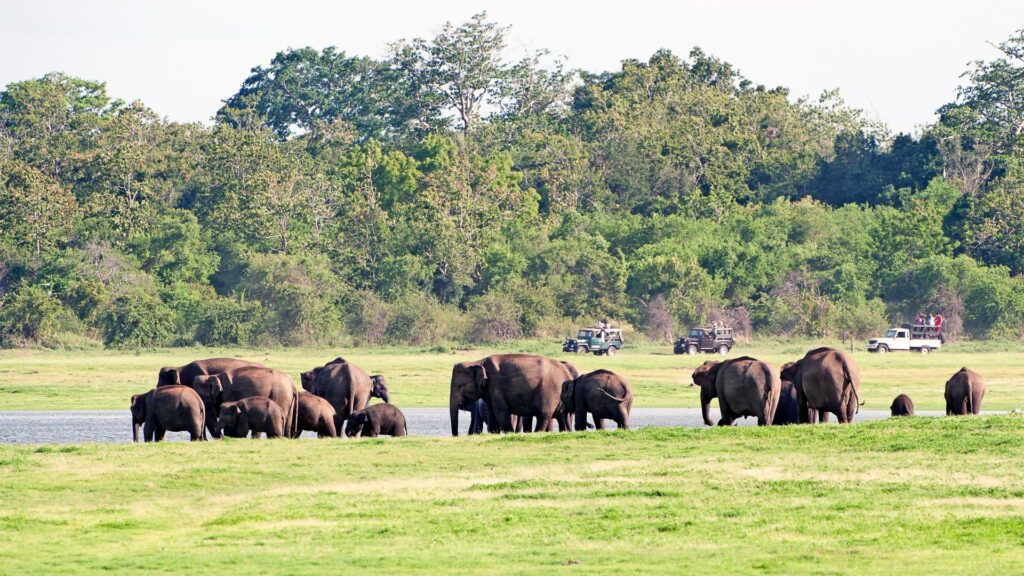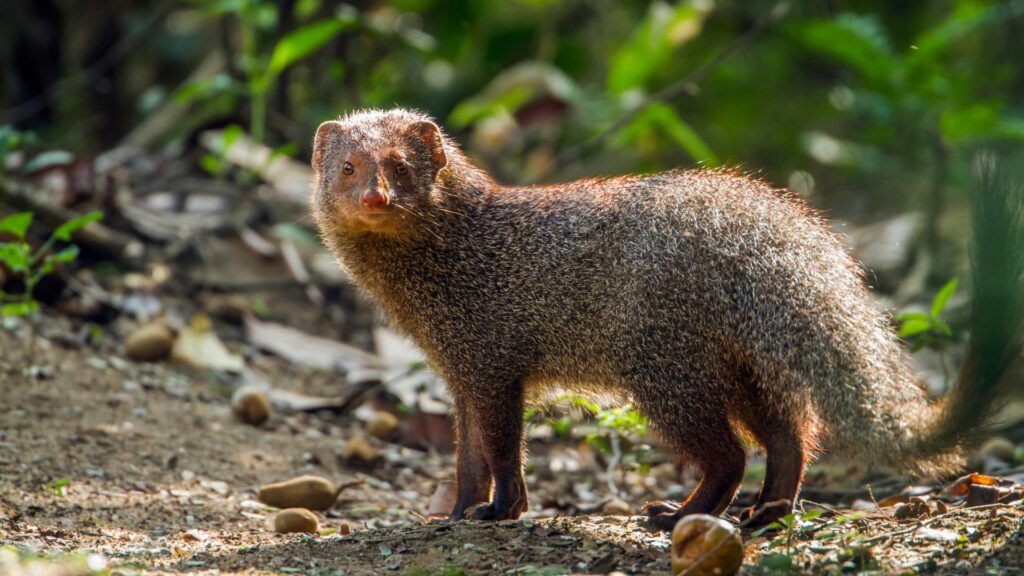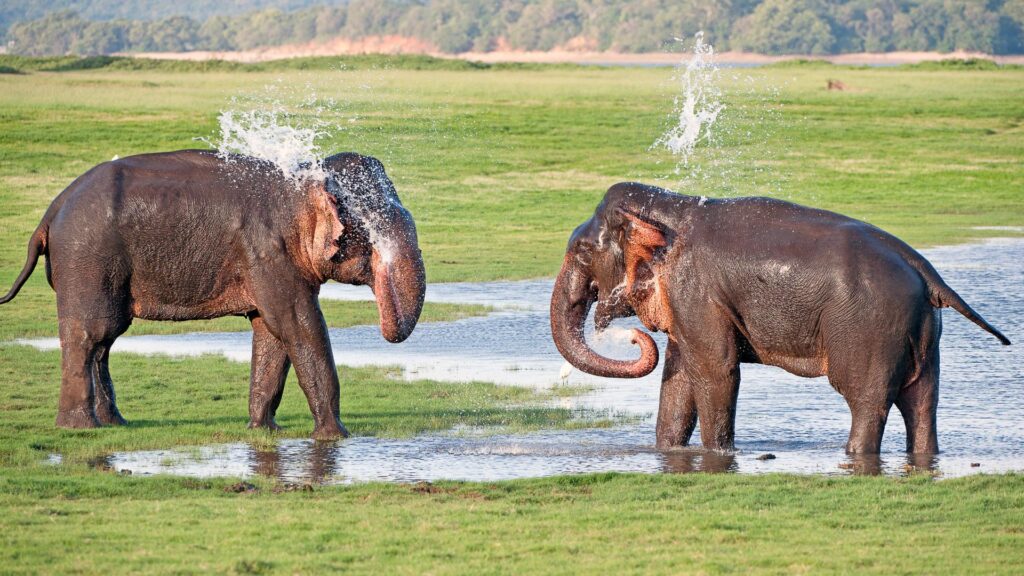Unveiling the Wild Beauty: Exploring Minneriya National Park, Sri Lanka
Nestled in the Sri Lankan cultural triangle, the enchanting Minneriya National Park, is a true wildlife wonderland that attracts visitors with its diverse ecosystems and abundant wildlife. Let’s explore the allure and significance of this remarkable conservation hotspot, and why it’s a must-visit destination for nature enthusiasts.
Minneriya National Park: The Wild Beauty
Minneriya National Park, located in the North Central Province of Sri Lanka, is renowned for its rich biodiversity and stunning natural beauty. Spanning over 8,800 hectares, this park is a sanctuary for a wide array of flora and fauna, including endemic species unique to Sri Lanka.
Brief History and Significance
The history of Minneriya National Park dates back to ancient times when it served as a designated area for wildlife protection by the Kings of Sri Lanka. Over the years, efforts to conserve its natural treasures have elevated Minneriya to its current status as a protected area under the Department of Wildlife Conservation.
One of the park’s most significant features is the ancient Minneriya Tank, built by King Mahasen in the 3rd century AD. This reservoir not only provides vital water sources for the park’s inhabitants but also attracts a spectacular gathering of wildlife during the dry season, earning Minneriya its reputation for hosting the famous “Gathering of Elephants.”

What Makes Minneriya a Must-Visit Destination
- The Gathering of Elephants: Witnessing hundreds of elephants congregating around the Minneriya Tank during the dry season (from July to October) is a sight to behold. This natural phenomenon, known as the “Elephant Gathering,” offers a rare opportunity to observe these majestic creatures in their natural habitat.
- Diverse Wildlife: Apart from elephants, Minneriya is home to a diverse range of wildlife, including leopards, sloth bears, sambar deer, and a plethora of bird species. Birdwatchers will be delighted by the park’s avian population, which includes endemic and migratory birds.
- Scenic Landscapes: The park’s varied landscapes, comprising grasslands, wetlands, and dense forests, create picturesque backdrops for wildlife sightings and nature walks. Jeep safaris and guided tours offer visitors a chance to explore these landscapes while learning about the park’s conservation efforts.
- Conservation Success: Minneriya National Park stands as a testament to successful conservation practices in Sri Lanka. Efforts to protect its ecosystems and wildlife have led to notable conservation achievements, making it a model for sustainable tourism and environmental preservation.
Symphony of Life: Fauna & Flora in Minneriya National Park

Minneriya National Park stands as a testament to the island’s rich biodiversity. This natural haven boasts a diverse range of fauna and flora, making it a must-visit destination for wildlife enthusiasts and nature lovers alike.
Incredible Biodiversity
Minneriya National Park is renowned for its impressive array of wildlife. The park is perhaps best known for its large population of Asian elephants, which can often be seen gathering near the Minneriya Tank during the dry season. These majestic creatures, along with other wildlife such as leopards, sloth bears, sambar deer, and spotted deer, contribute to the park’s vibrant ecosystem.
In addition to its mammals, Minneriya is also home to over 170 species of birds, including colorful kingfishers, majestic eagles, and elusive owls. Birdwatchers will find plenty to marvel at as they explore the park’s varied habitats, from lush forests to open grasslands.

Insider Insights
For those hoping to catch a glimpse of Minneriya’s iconic wildlife, timing is key. The dry season, which typically runs from June to September, is the best time to visit as it coincides with the elephants’ annual gathering known as “The Gathering.” During this spectacle, hundreds of elephants congregate near the Minneriya Tank, creating a breathtaking sight that is unparalleled in its grandeur.
Aside from elephants, visitors can also spot a wide range of wildlife throughout the year. Early morning and late afternoon jeep safaris offer the best chances of encountering elusive species such as leopards and sloth bears. Knowledgeable guides and rangers can provide valuable insights and enhance the overall wildlife viewing experience.
Ecological Importance and Conservation Efforts
Beyond its tourism appeal, Minneriya National Park plays a vital role in conservation efforts and preserving Sri Lanka’s natural heritage. The park’s diverse flora, including towering trees, vibrant orchids, and medicinal plants, supports a complex ecosystem that sustains numerous species of wildlife.
Conservation initiatives within the park focus on habitat preservation, anti-poaching measures, and community engagement. By raising awareness about the importance of conservation and sustainable tourism practices, Minneriya National Park aims to ensure that future generations can continue to marvel at its natural wonders.
Navigating the Path: Accessible Routes to Minneriya National Park
For those eager to explore the wonders of Minneriya National Park in Sri Lanka, reaching this natural paradise is a straightforward yet exciting journey. Here’s a guide to help you navigate the accessible routes from major cities and tourist hubs like Colombo and Kandy to the park entrance.
Directions from Colombo
If you’re starting your journey from Colombo, the capital city of Sri Lanka, you’ll embark on a scenic drive that takes approximately 4-5 hours, covering a distance of about 180 kilometers. Here’s the route:
- Start from Colombo and head east on the A1 highway toward Kandy.
- Continue on the A1 highway until you reach Dambulla.
- From Dambulla, take the Sigiriya-Minneriya Road (B275) and follow the signs leading to Minneriya National Park.
Directions from Kandy
Traveling from Kandy to Minneriya National Park is a shorter trip, taking around 2-3 hours and spanning approximately 100 kilometers. Follow these directions:
- Begin in Kandy and head north on the A9 highway toward Matale.
- In Matale, take the Dambulla-Matale Road (A9) until you reach Dambulla.
- From Dambulla, follow the Sigiriya-Minneriya Road (B275) to reach the park entrance.
Transportation Options
For convenience and flexibility, several transportation options are available:
- Private Vehicles: Renting a car or hiring a private driver gives you the freedom to explore at your own pace. Ensure your vehicle is suitable for rough terrain if you plan to venture off-road within the park.
- Public Buses: Public buses operate from Colombo and Kandy to Dambulla. From Dambulla, you can hire a tuk-tuk or taxi to reach Minneriya National Park.
- Guided Tours with us: Opting for a guided tour not only simplifies transportation but also provides knowledgeable guides who can enhance your experience with insights about the park’s wildlife and history.
Travel Tips
- Road Conditions: The roads leading to Minneriya National Park are generally well-maintained, but some rural areas may have narrower roads or occasional potholes. Drive with caution, especially during rainy seasons.
- Travel Time: Plan your journey with ample time, especially if you’re visiting during peak tourist seasons when traffic may be heavier.
- Recommended Stops: Along the way, consider making stops at attractions like the Dambulla Cave Temple, Sigiriya Rock Fortress, or spice gardens in Matale (if you are traveling from Kandy) to enrich your journey with cultural and historical experiences.
Unraveling Nature’s Tapestry: Geographic Features of Minneriya
Minneriya National Park in Sri Lanka is a stunning mosaic of diverse landscapes, each contributing to the park’s rich ecological tapestry. Let’s look into the geographic features that make Minneriya a breathtaking destination for nature enthusiasts.
Lush Forests
One of the defining features of Minneriya National Park is its lush forests that cloak the park in verdant hues. These forests, predominantly dry zone forests, are home to a plethora of plant species, including towering trees, flowering shrubs, and aromatic herbs. As you traverse the park’s winding trails, you’ll be immersed in a symphony of bird calls and the rustle of leaves, providing a serene backdrop to your wildlife encounters.
Open Grasslands
Contrasting with the dense forests are the open grasslands that stretch across Minneriya. These expansive grasslands offer unobstructed views of the surrounding landscape and are favored by wildlife such as elephants, deer, wild buffalo, and numerous bird species. The vastness of the grasslands adds a sense of grandeur to the park, inviting visitors to witness the beauty of untamed nature.
The Iconic Minneriya Tank
At the heart of Minneriya National Park lies its most iconic feature—the Minneriya Tank. This ancient reservoir, dating back to the third century AD, serves as a vital watering hole for wildlife, especially during the dry season. The significance of the tank becomes apparent during the famed elephant gatherings, where hundreds of elephants converge to quench their thirst and engage in social interactions. This natural spectacle is a sight to behold, epitomizing the harmonious relationship between wildlife and their environment.
Magical Landscapes
Visitors to Minneriya National Park are treated to a visual feast of stunning landscapes. From the tranquil waters of the Minneriya Tank reflecting the azure sky to the golden hues of the grasslands at sunset, every corner of the park exudes natural beauty. Photographers and nature enthusiasts alike will find endless opportunities to capture the essence of Sri Lanka’s wilderness through vivid imagery.
Visitor Experiences
Numerous visitors to Minneriya National Park recount awe-inspiring experiences amidst its geographic wonders. From witnessing herds of elephants splashing in the Minneriya Tank to encountering elusive leopards prowling through the forests, each moment spent in the park is a testament to nature’s grandeur. These firsthand anecdotes serve as a testament to the park’s enduring allure and the unforgettable memories it creates.
Climate of Minneriya National Park
Understanding the climate of Minneriya National Park is key to planning a memorable and enjoyable visit to this natural gem in Sri Lanka. Let’s delve into the park’s climate patterns, packing tips, and seasonal recommendations for visitors looking to embrace nature’s moods.
Overview of the Climate
Minneriya National Park experiences a tropical climate typical of Sri Lanka’s dry zone. The park is characterized by distinct monsoon seasons and dry spells, each contributing to the unique rhythms of nature within its borders.
- Monsoon Seasons: The primary monsoon seasons in Sri Lanka are the southwest monsoon (May to September) and the northeast monsoon (November to February). During these periods, rainfall is more frequent, and vegetation flourishes, creating lush landscapes within the park.
- Dry Spells: The dry season in Minneriya National Park spans from June to September, coinciding with the southwest monsoon in other parts of the country. This period sees reduced rainfall, leading to drier conditions and the gradual drying up of water sources.
Packing Tips and Seasonal Recommendations
To make the most of your visit to Minneriya National Park, consider the following packing tips and seasonal recommendations:
- Dry Season (June to September): If you’re visiting during the dry season, pack lightweight and breathable clothing suitable for hot and sunny weather. Don’t forget essentials like sunscreen, a hat, a dust mask, and insect repellent. This period is ideal for witnessing the famous elephant gatherings near the Minneriya Tank.
- Monsoon Seasons (May to September, November to February): During monsoon seasons, be prepared for occasional showers by packing waterproof clothing and sturdy footwear. The lush vegetation and increased water availability make this time perfect for birdwatching, as migratory birds flock to the park.
Unique Experiences
Embracing nature’s moods in Minneriya National Park offers unique experiences that vary with the seasons:
- Birdwatching: Visit during migratory seasons (usually from August to April) to witness a vibrant array of migratory bird species adding color to the park’s landscapes. Keep your binoculars handy for spotting rare and beautiful birds.
- Elephant Gatherings: Plan your trip during the dry season (June to September) to witness the awe-inspiring spectacle of hundreds of elephants gathering near the Minneriya Tank. This natural phenomenon is a highlight for wildlife enthusiasts and photographers alike.
Dos and Don’ts in Minneriya National Park
As you engage in your adventure to Minneriya National Park in Sri Lanka, it’s crucial to observe proper etiquette to ensure a harmonious and respectful experience in the wilderness. Here are essential dos and don’ts to keep in mind during your visit.
Responsible Wildlife Viewing
- Do Maintain a Safe Distance: While observing wildlife, maintain a safe distance to avoid disturbing their natural behaviors. Respect the boundaries set by park authorities and guides to ensure both your safety and the well-being of the animals. Sometimes the jeep drivers may drive very close to wild animals expecting a good tip but tell them that you are a responsible tourist and not to harm the peace of the animal.
- Don’t Feed or Approach Animals: Refrain from feeding wild animals or approaching them too closely. Feeding wildlife can disrupt their diet and behavior, while approaching them can cause stress and aggression.
- Don’t disturb the other visitors’ observations and news as in nature it is about luck to spot a rare wildlife, thus respect that.
Respecting Nature
- Do Dispose of Waste Properly: Carry a small trash bag with you and dispose of litter in designated bins within the park. Avoid leaving any waste behind, as it can harm the environment and wildlife. Most of the Jeep drivers also have their own trash bins inside their safari jeeps.
- Don’t Litter or Pollute: Respect the park’s pristine environment by refraining from littering, including plastics and non-biodegradable materials. Help preserve the natural beauty of Minneriya for future generations to enjoy.
Following Park Regulations
- Do Follow Park Rules: Familiarize yourself with and adhere to the park’s regulations regarding entry, wildlife viewing, and safety protocols. Obeying these rules helps protect the park’s ecosystems and ensures a positive experience for all visitors.
- Don’t Venture Off Designated Trails or jeep tracks: Stick to designated trails and paths to minimize impact on vegetation and wildlife habitats. Avoid straying into restricted areas to preserve the park’s natural balance.
Cultural Sensitivities
- Do Respect Local Communities: If interacting with local communities or encountering cultural sites, show respect for local customs and traditions. Seek permission before taking photographs and engage with locals in a friendly and courteous manner.
- Don’t Disrupt Sacred Sites: Minneriya and its surrounding areas may have sacred sites or cultural landmarks. Avoid causing disturbances or disrespecting these places, and follow any guidelines provided by guides or locals.
Conclusion
Minneriya National Park is a beautiful blend of nature, culture and conservation in Sri Lanka. It’s a place where you can see stunning landscapes, diverse wildlife, and rich culture come together.
We invite you to visit Minneriya with us and experience its magic firsthand. Share your feedback, stories, and travel plans to inspire others to explore and protect our natural treasures.
Come, discover the wonders of Minneriya National Park and create lasting memories in Sri Lanka’s wildlife sanctuary with Zigma Tours.
